|
Motorcycle News - Chuch of MO: 2008 Suzuki B-King
https://ift.tt/2JzAWeT 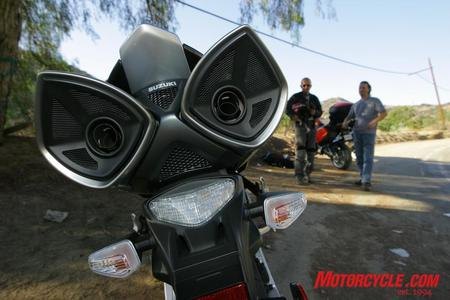 And so it was written, I’ll B-King when dogs get wings. This rare Suzuki sounds like a great used naked bike if you’re in the market, and nearly new at ten years old. 2008 Suzuki B-King ReviewNo cartoon character
By Mark Gardiner Sep. 16, 2008
Photos by Alfonse “Fonzie” Palaima
My neighbor took one look at it and said, “They should have used that in the new Batman movie.”
That sums up the first impression the Suzuki B-King made on me, too. It looks like something out of a comic book. Frankly, I expected it to ride that way, too. Big, heavy; all form, no function. Still, it was a bike, and it’s not as though I really get to pick which ones I test, so after the most rudimentary of formalities, I traded Motorcycle.com’s GSX-R600 in for the baddest naked bike around. (Well, it was the baddest when I picked it up, just before Yamaha launched the new V-Max. Until we ride them together we won’t know for sure.)
“The bike’s not a laughing stock. Far from it.” Although the B-King’s seat is not particularly high, the bike looked as huge from the vantage point of the saddle as it had when I first walked up to it. Shifting it off the sidestand, it felt heavy too. “Here we go,” I thought “this thing’s going to be a pile.” The first stop, just a few minutes from Suzuki’s bat-cave, was the Area P dyno room where I’d be meeting up with the MO crew. Even on the short ride, I was already suffering from a little cognitive dissonance because the riding experience was better than I’d expected. But once I met up with Kevin, Pete and Fonzie at Area P, we regaled ourselves at the expense of the B-King’s over-the-top styling. We decided that we’d go for lunch at Burger King, since this bike was such a whopper. Ha, ha. We kill us. We actually did go to Burger King, and got one of those stupid cardboard crowns they give out with the kid’s menu, and we taped it to my helmet and took some pictures of me riding that way. We laughed some more, imagining the “I’m so hurt you’d mock our bike” calls we’d be getting from Suzuki’s press relations department. There’s just one catch. The bike’s not a laughing stock. Far from it. Oh, it’s got lots of power, which we all expected. But it’s also got great brakes and frankly amazing handling. It’s comfortable, with the best wind protection I’ve ever experienced without a windscreen, and great ergonomics. I rode 150 miles before the fuel warning flashed on the dash, which is as far as I ever want to ride before stopping to drain my own tank and recaffienate, anyway. No kidding, I could throw soft luggage and a tank bag on this thing and take it sport touring. Or take the mirrors off it, tape over the lights, and take it to a track day. How the heck did that happen? Suzuki introduced the 1298cc Hayabusa in 1999. It was the undisputed heavyweight champion in the raw-speed stakes and quickly attracted the interest of horsepower addicts, whether they were racing on the Bonneville Salt Flats in daylight, or on some deserted road in an industrial subdivision after midnight. More than a few of them supercharged their ’Busas, or devised turbocharging or nitrous-injection systems. In 2001, the motorcycle industry decided to end the top-speed arms race, with a self-imposed 186-mph governor on future models. Only 186? That sort of took the raison d’etre away from the Hayabusa. Then someone at Suzuki had a brainstorm. What if we took one of those supercharged ’Busa motors and put it in a big naked bike? On the face of it, that was a patently ridiculous notion. Imagine the poor rider, snapping like a flag in the wind, as his arms stretched like rubber bands, hanging onto it for dear life. Still, it was a compelling concept for a show bike, and Suzuki built one for the 2001 Tokyo Motor Show. That original B-King made an initial impression as huge as its 240-section rear tire. Faced with a global chorus of, “Please, please, please build one like that, that I can buy,” Suzuki setabout turning it into reality. The supercharger didn’t make it into the production version (and trust me, it’s not needed) but the rest of the model stayed remarkably close to the original show bike.
In the interim – perhaps in response to Kawasaki’s impressive ZX-14 – Suzuki stroked the ’Busa motor by two millimeters, boosting displacement to 1340cc. There were a number of other changes including Ti valves and higher compression pistons that added up to a non-trivial increase in power. That’s the motor that the B-King gets, which is notable in a world where manufacturers often seem to give their naked bikes previous-gen motors. (Obviously, doing so allows them to get more use out of old tooling and to control costs.) The only differences between the ’Busa motor and the B-King’s is that the latter’s underseat exhaust routing is a little more restrictive, it’s airbox is about 15% smaller and doesn’t have a ram-air inlet, and the rev limiter cuts in sooner.
Don’t worry about it. On Area P’s dyno, the B-King produced a hair under 160 rear-wheel horsepower with that 9,500 rpm rev limit. That compares to 168 hp for the ’Busa at 11,000. More to the point, the B-King produces just under 97 pound-feet of torque. That’s indistinguishable from its streamlined brother, especially considering that you have no reason to rev either motor out. The impression created on the street is one of seamless, limitless power in almost any gear at any speed. Although the shape of the horsepower and torque curves are the same right up to the B-King’s lower rev limit, it feels even more potent than a Hayabusa off the bottom. I knew the internal gear ratios were the same, but I called Suzuki to ask if the B-King had different final drive gearing, which might have accounted for the difference in the readings from my seat-of-the-pants dyno. “No,” I was told, “both bikes are 18-43 (teeth at the countershaft and rear sprocket.)” “Maybe the B-King is lighter, then?” I asked hopefully. But I learned it’s actually a bit heavier.
All I can conclude is that the ’Busa’s sportier riding position masks that torque, and that the B-King’s upright stance exaggerates it a little. Whatever the case, on a long and unobstructed freeway on-ramp, the B-King pulls like a pit bull that’s just realized Fifi the poodle is in heat, somewhere just upwind. On the freeway, an indicated 80 mph in top gear shows 4,000 rpm on the tach. The bike has top-gear roll-on performance that compares to a lot of bikes’ fourth-gear stomp, so passing is effortless. At that cruising speed, the B-King has the best wind protection ever for a naked bike. I don’t know how stylist Satoshi Isokari did it, because the headlight and clocks seem, if anything, lower than other naked bikes. But somehow, I experienced less wind noise, buffeting and neck strain than I did when I recently rode a partly-faired BMW K1200R Sport. At that speed, the handlebars transmitted no vibrations at all. There was the slightest buzz every now and then from the seat or pegs, as different components came in and out of phase. The mirrors were the only place that seemed to resonate most of the time, although their position was good; overall, the rearward visibility was still average. (The concept bike had a rear-facing camera and little television built into the tank, which wouldn’t have been any better!) In any case, there’s no reason you should ever be caught from behind on this bike. To the right of the ignition slot is the drive-mode selector, which offers an A or B choice only. If you’re familiar with the A-B-C choice on the GSX-Rs, note that the B-King really offers something more like A and C. That is to say, in B mode, it peaks at 114 hp. Frankly, I didn’t try it. The throttle is so easy to modulate, that I don’t think I’d remember to hit the switch even in the rain. The ’Busa-derived motor had big respect going in, so the power was expected, and the functional ergos were a nice surprise. The B-King’s handling though… that’s almost a shock. The frame and suspension are unique to the B-King; Suzuki didn’t just take the fairing off the ’Busa and slap a wide bar on it. The frame itself – a high-tech, variable-thickness casting job – looks like something that would support a bridge. I guess I should say that the Kayaba fork and shock are “adjustable,” since the term “fully adjustable” now probably implies separate high- and low-speed compression damping. For the record, the available adjustments are spring preload, and compression and rebound damping. There’s no easy way to adjust ride height at the rear.
Considering that the bike’s a little longer and heavier than the Hayabusa, with a longer swingarm and more rake and trail, it’s amazingly light on its feet. The wide handlebar is perfectly positioned for good leverage, but there’s more to it than that. A lot of upright bikes don’t really give you a way to exploit that leverage, because you can’t ‘lock’ your body in position the way you can when you have rear-set footpegs to push against. So if you wrench on the ’bar, some of your steering input is wasted when your body moves on the seat.
“If I was looking for a streetbike, that (B-King) would be high up on my list.” Take a second look at that comically wide-shouldered tank/airbox area. Those air intakes are just styling elements, and the whole bodywork assembly is so wide that they can mount the turn signals on it. Since I like to put as much weight on the front as I can, I always sit as far forward as I can, which means that on the B-King, I’m almost doing the splits around the tank. But what that does is, it locks my body in position. As a result, I can really work the handlebar, and it makes the bike a lot more responsive than I expected it would be. That’s not just my impression, either. “I thought that canyon roads would reveal the B-King to be a wallowing sow,” MO staffer Pete Brissette notes. “Not so. I was excited to discover that rolling the bike through a series of turns was as effortless and precise as the handling offered by any good sportbike available today. The chassis is stout, with well-sorted suspension, front and rear.” The whole process of getting this big, powerful bike slowed, turned, and then accelerating through and out of a corner works. The transmission shifts perfectly; the clutch pull is light – very light, considering the power it has to transmit – and it is a slipper type so there’s no wheel hop if your throttle-blipping skills are uneven. A conventional master cylinder actuates radial-mount Tokico calipers grabbing 310mm discs. The initial bite is good, with great strength and feel for trail-braking. The 43mm Kayaba fork (and shock) strike a good compromise between comfort and control. Dunlop Qualifier tires – which can almost be too quick to turn on bikes with sharper geometry – help the bike change direction. Once it’s leaned over, the excellent fuel mapping ensures a smooth throttle take-up, which is reassuring with so much torque at low rpm! And of course, once you’ve got it back on the fat part of the tire, there’s all the power you dare use. I wish I could get this thing to a track day. My friend Chris Van Andel, who works for MotionPro and is a partner in the Zoom Zoom track-day business up in NorCal told me, “I rode one at Thunder Hill. It’s rad, and handles better than anything that size has a right to. Then, you pull the pin down the front straight and it’s Millennium Falcon hyperspace time. If I was looking for a streetbike, that (B-King) would be high up on my list.” Speaking of ‘high’ that massive underseat exhaust raises the passenger seat up, too. The Chick used my footpeg to climb up onto it, since the passenger peg was high, too. Once in position, she found the seat better than average (she’s used to sportbikes) and she commented on the bike’s smoothness and surprising lack of wind buffeting. I was pleasantly surprised by predictable slow-speed handling even with a passenger perched way up there.
It seems funny to even bother commenting on the B-King’s ease of use when poking around town with a passenger on board. Ridden aggressively, the bike’s low- to mid-30 mpg fuel consumption is not good, by motorcycle standards (I got about 40 in normal freeway use), but in most other ways it proved surprisingly versatile and functional as a vehicle.It’s certainly not cheap, with an MSRP of $12,899. (The ABS version, not tested, is $13,499.) Although the styling takes some getting used to, the overall build quality and fit-and-finish are first rate. The basic architecture of the Hayabusa motor may be a decade old, but it’s a beauty; powerful and almost bulletproof. It’s no accident this is still the king of horsepower shootouts. And the changes that marked its growth to 1340cc brought it fully up to date. The B-King is definitely not some long-in-the-tooth sportbike that’s been stripped of its bodywork and repackaged for around-town riding. I bet Suzuki think of this as their flagship. For comparison purposes, the Triumph Speed Triple is less at $10,399; the BMW K1200R is more at $13,920; and if you can get one any time soon, I’m guessing you’ll pay the full list price of $17,990 for an ’09 V-Max.Despite my initial skepticism and that cartoonish first impression, I now highly recommend the Suzuki B-King – especially to big guys, who aren’t comfortable riding crotch rockets with their heels touching their asses and their knees in their armpits. You can cruise on it, surprise a lot of people in the canyons, commute, and stare down anyone at any red light anywhere. I could go on, but I have to go. Amazingly, considering I’m riding a bike that approaches 580 pounds (full of fuel) I hear Mount Palomar calling… Related Reading: The post Chuch of MO: 2008 Suzuki B-King appeared first on Motorcycle.com. Motorcycles via Motorcycle.comMotorcycle.com https://ift.tt/Xzx9iy June 10, 2018 at 06:38PM Leave a Reply. |
�
Categories
All
Archives
November 2020
|


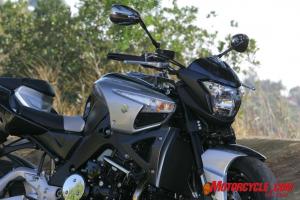 The
The 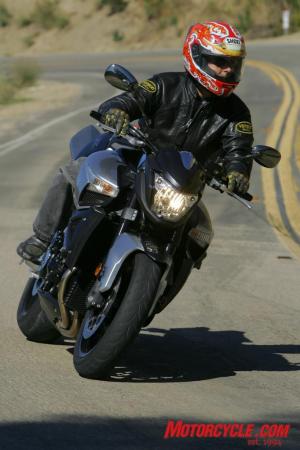 It’s good to be king!
It’s good to be king!
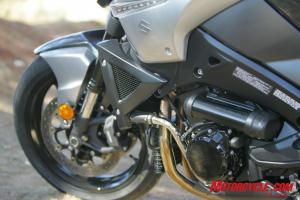 That cylinder is not the Bat-zooka, Robin; it’s the carbon canister – part of the emissions control. Even though the bike’s ‘naked,’ the new 1340cc Hayabusa-sourced motor is still concealed by all that plumbing and two stout frame spars.
That cylinder is not the Bat-zooka, Robin; it’s the carbon canister – part of the emissions control. Even though the bike’s ‘naked,’ the new 1340cc Hayabusa-sourced motor is still concealed by all that plumbing and two stout frame spars.
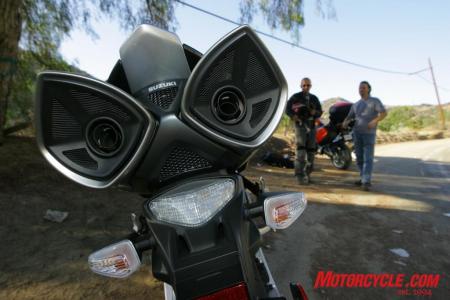 The B-King’s design is polarizing, with some of our crew deciding the twin undertail exhaust outlets are simply over the top.
The B-King’s design is polarizing, with some of our crew deciding the twin undertail exhaust outlets are simply over the top.
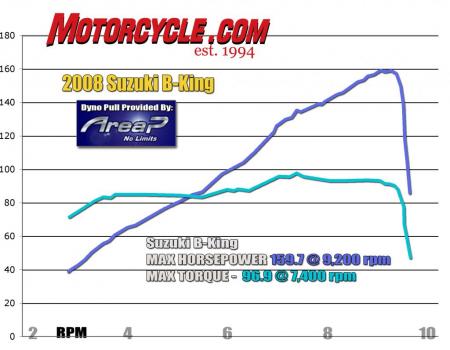 The torque curve – and I use the word loosely – tells the story. The B-King makes more torque at 4,000 rpm than a GSX-R1000 makes at its peak. The ’08 ’Busa’s curves are identical, although horsepower climbs for a few hundred more revs, then there’s another grand available in overrun.
The torque curve – and I use the word loosely – tells the story. The B-King makes more torque at 4,000 rpm than a GSX-R1000 makes at its peak. The ’08 ’Busa’s curves are identical, although horsepower climbs for a few hundred more revs, then there’s another grand available in overrun.
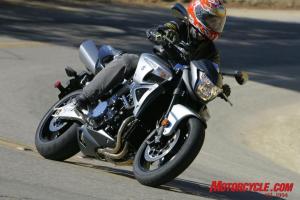
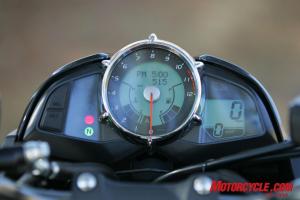
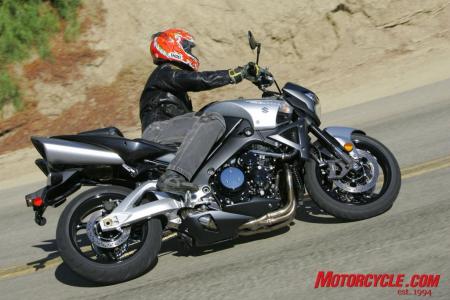 Still nowhere near the limits of the sticky
Still nowhere near the limits of the sticky 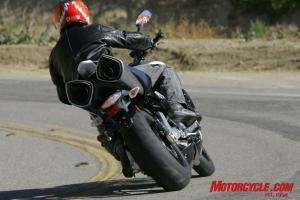 The uniquely styled B-King puts the funky in functional.
The uniquely styled B-King puts the funky in functional.
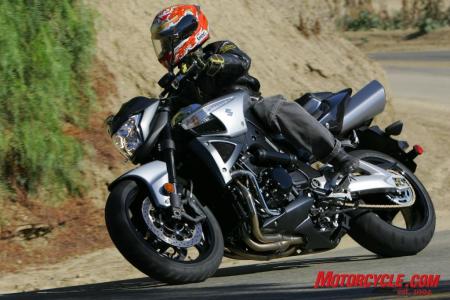 Relatively roomy ergos make the B-King usable in all kinds of riding environments, even commuting.
Relatively roomy ergos make the B-King usable in all kinds of riding environments, even commuting.
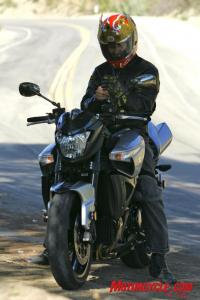
 RSS Feed
RSS Feed

6/10/2018
0 Comments